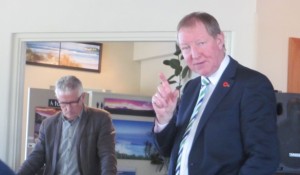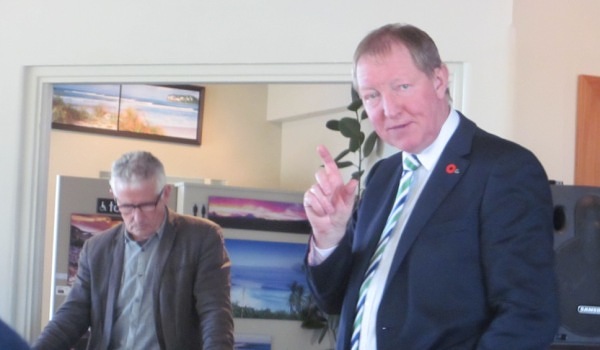
Dr Nick Smith struggled to make points at a luncheon meeting at the Orca in Raglan On Friday 22nd. About 45 people were along to hear the Minister of Conservation speak at the event organised by the Raglan Chamber of Commerce. Speaking loudly and clearly, Dr Smith covered environmental issues, Auckland housing and exempting farm buildings from earthquake provisions. The meeting then opened up for what RCoC Chair Dave Currie said was to be a conversation with the Minister. While Dr Smith’s answers to questions during the converstion might have gone down well with the National Party faithful, he struggled speaking to an audience informed on environmental issues.
Dr Smith said that species extinction was the main environmental issue facing New Zealand today saying we were 193 down the global list on what we were doing about it. When then asked about protection measures for the Maui dolphin, he said that there was 100% coverage with observers on trawlers. When Sheryl Hart, from the Raglan Sport Fishing Club pointed out that this was incorrect as there were no observers on trawlers operating in the main Maui dolphin area from one to seven nautical miles offshore, he said he would have to check.
Phil McCabe of KASM asked about seismic testing in the Maui dolphin habitat. Dr Smith said that seismic testing equipment was so sensitive that only a bubble of air was needed now. When Phil pointed out that the ‘bubble’ was an explosion that sent a shudder through your body if you were in the water at the time, Dr Smith backtracked and agreed.
His justification for more oil drilling was that New Zealand would soon run out of natural gas to fuel power stations. He said that when the gas ran out we would have to build coal-fired stations and that would be bad for the environment. Strange that he would propose coal power stations when geothermal is cheaper and cleaner than coal. Also he must be unaware that the US Government analysis confirms that solar electric is now at parity with construction of new coal-fired stations.
Speaking about water quality he said that a major issue was diffuse pollution. His statements and the following conversations revealed that he was unaware that the edge planting approach that solves this type of pollution has been pioneered around Raglan Harbour.
He answered John Lawson’s question about polluted rivers by saying that very few rivers are being monitored and suggesting that therefore the degree of pollution is being exaggerated. John has now emailed the Minister saying,
Were you referring to the NIWA run NRWQN?
http://www.niwa.co.nz/publications/wa/water-atmosphere-1-july-2010/how-clean-are-our-rivers says the network regularly samples 77 sites, including 35 major rivers that drain 50% of our land area, and reports the Director of Information at the Ministry for the Environment as saying, “It gives a really good overview of what’s going on” with water quality.
Furthermore, in 2013 the Parliamentary Commissioner for the Environment reported (http://www.pce.parliament.nz/assets/Uploads/PCE-Water-quality-land-use-web-amended.pdf), based on a major modelling exercise, that, “Unfortunately, if we continue to see large-scale conversion of land to more intensive uses, it is difficult to see how water quality will not continue to decline in the next few years. This is despite the best efforts of many and some undoubted successes.”
The overall impression Dr Smith gave was of a Minister not properly briefed by his officials and there being some giant gaps in the science used by the National Party as the base for its blue-green environmental and economic development policies.

